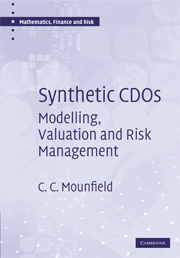Book contents
- Frontmatter
- Contents
- Preface
- Acknowledgements
- 1 A primer on collateralised debt obligations
- 2 Modelling of obligor default
- 3 Valuation of credit default swaps
- 4 Credit indices
- 5 Valuation of default baskets
- 6 Valuation of synthetic CDOs
- 7 Phenomenology of the standard market model
- 8 Risk quantification of synthetic CDOs
- 9 Implied and base correlations
- 10 Extensions of the standard market model
- 11 Exotic CDOs
- 12 Correlation trading of synthetic CDO tranches
- 13 Risk management of a portfolio of synthetic CDOs
- 14 Hedging simulation of structured credit products
- Appendix A Explanation of common notation
- Appendix B Simulated annealing
- References
- Index
12 - Correlation trading of synthetic CDO tranches
Published online by Cambridge University Press: 06 July 2010
- Frontmatter
- Contents
- Preface
- Acknowledgements
- 1 A primer on collateralised debt obligations
- 2 Modelling of obligor default
- 3 Valuation of credit default swaps
- 4 Credit indices
- 5 Valuation of default baskets
- 6 Valuation of synthetic CDOs
- 7 Phenomenology of the standard market model
- 8 Risk quantification of synthetic CDOs
- 9 Implied and base correlations
- 10 Extensions of the standard market model
- 11 Exotic CDOs
- 12 Correlation trading of synthetic CDO tranches
- 13 Risk management of a portfolio of synthetic CDOs
- 14 Hedging simulation of structured credit products
- Appendix A Explanation of common notation
- Appendix B Simulated annealing
- References
- Index
Summary
The market can stay irrational longer than you can stay solvent.
John Maynard KeynesIntroduction
The previous chapters have presented models for the valuation, analysis and calibration of synthetic CDOs. In this chapter we analyse some of the more common trading strategies involving synthetic CDOs that have been employed in the marketplace and introduce the concept of correlation as an asset class to trade.
Originally credit derivatives were developed in order to isolate and hedge specific credit risks, essentially removing that risk from the balance sheet. They were illiquid instruments. Once off the balance sheet the protection seller no longer needed to hold regulatory capital against the potential loss of the underlying capital (thereby freeing up this capital for more profitable investments). The positions were typically buy-and-hold until maturity and very bespoke to the requirements of particular clients. With the advent of liquid markets trading standardised products this changed.
Probably the single biggest impact of liquid markets in portfolio products has been the emergence of a new asset class to trade: correlation. Valuing a synthetic CDO requires single obligor credit spreads and recovery rates as inputs. These are typically observable in the market and the values are (more or less) agreed upon by all market participants. The final fundamental input is the default correlation. As we have seen in Chapter 9, market participants strip from observed prices an implied correlation number.
- Type
- Chapter
- Information
- Synthetic CDOsModelling, Valuation and Risk Management, pp. 249 - 276Publisher: Cambridge University PressPrint publication year: 2008



